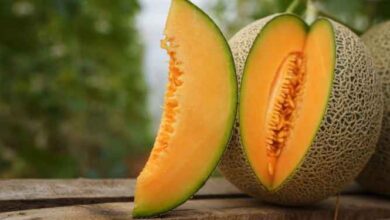
Weird Food Facts: Surprising Truths About What We Eat
Weird food facts: Ever wondered why ketchup is considered a vegetable? Or why the average person eats around 8 spiders in their sleep each year? The world of food is filled with strange and fascinating tidbits that often leave us scratching our heads.
From the origins of our favorite dishes to the science behind food allergies, there’s a whole lot more to discover than meets the eye.
Join me on a journey through the bizarre and wonderful world of food, where we’ll explore the unexpected origins of common foods, the fascinating science behind flavors and textures, and the diverse cultural traditions that shape our eating habits. We’ll also delve into the impact of technology on food production, the importance of food safety, and the global challenge of food waste.
Food Culture and Traditions

Food is more than just sustenance; it’s a powerful reflection of culture, history, and identity. Culinary traditions and customs vary widely across the globe, offering a fascinating glimpse into the unique ways different societies interact with food.
Diverse Food Customs and Traditions
Food customs and traditions are deeply ingrained in various cultures, shaping how people prepare, consume, and share their meals. Here’s a glimpse into some diverse food customs and traditions around the world:
| Region | Custom | Description |
|---|---|---|
| Japan | Osechi Ryori | A traditional Japanese New Year’s feast featuring elaborately prepared dishes with symbolic meanings, such as black beans for good health and herring roe for prosperity. |
| Mexico | Día de los Muertos | The Day of the Dead celebration involves building altars adorned with offerings of food and drink for deceased loved ones, including sugar skulls, pan de muerto (bread of the dead), and mole sauce. |
| India | Thali | A traditional Indian meal served on a large platter with multiple compartments containing various dishes, showcasing the diverse flavors and culinary techniques of the region. |
| France | Le Grand Repas | A formal French multi-course meal typically consisting of an appetizer, soup, main course, cheese course, dessert, and coffee, emphasizing the importance of fine dining and culinary artistry. |
Unusual Food Festivals and Celebrations
Food festivals and celebrations provide a unique window into the cultural and culinary landscape of a region. Here are some unusual food festivals and celebrations from around the world:
- San Gennaro Festival, New York City, USA:A vibrant celebration of Italian heritage featuring street vendors selling traditional Italian food, particularly the famous San Gennaro sausage.
- World’s Largest Lobster Roll Eating Contest, Maine, USA:A competitive eating contest where participants vie for the title of “Lobster Roll King” by consuming the most lobster rolls in a set time.
- The Running of the Bulls, Pamplona, Spain:This annual event features a dangerous but exhilarating spectacle where participants run through the streets with a herd of bulls, followed by a traditional Spanish feast.
- The Chocolate Festival, Peru:This festival celebrates the rich chocolate tradition of Peru with chocolate tastings, workshops, and parades featuring elaborately designed chocolate sculptures.
Cultural Significance of Specific Food Items
Specific food items often hold cultural significance, representing traditions, beliefs, and values. Here are some examples:
- Rice in Asia:Rice is a staple food in many Asian cultures, symbolizing abundance, prosperity, and fertility. In Japan, rice is considered sacred and is often used in religious ceremonies.
- Bread in Europe:Bread is a fundamental food item in many European cultures, representing sustenance, nourishment, and comfort. In France, bread is considered an essential part of a meal and is often served with butter or jam.
- Chiles in Mexico:Chiles are a vital ingredient in Mexican cuisine, adding heat, flavor, and depth to dishes. In Mexican culture, chiles are associated with passion, vitality, and strength.
Food Safety and Nutrition: Weird Food Facts

Food safety and nutrition are fundamental aspects of our well-being, influencing not only our physical health but also our overall quality of life. Understanding the science behind food safety regulations and debunking common food myths are crucial for making informed choices about what we eat.
Moreover, exploring the unexpected health benefits of certain foods can lead to a more balanced and enjoyable approach to nutrition.
Unexpected Health Benefits of Certain Foods, Weird food facts
The world of food is full of surprises, and some of the most ordinary foods hold unexpected health benefits. Here are a few examples:
- Dark Chocolate: While often associated with indulgence, dark chocolate, particularly with a high cocoa content (70% or more), is rich in antioxidants called flavonoids. These flavonoids have been linked to improved heart health, lower blood pressure, and enhanced cognitive function.
- Fermented Foods: Fermented foods like yogurt, kimchi, and sauerkraut are packed with beneficial bacteria known as probiotics. Probiotics contribute to a healthy gut microbiome, which plays a vital role in digestion, immunity, and overall well-being.
- Coffee: Coffee, often perceived as a stimulant, can provide a range of health benefits. Studies have shown that coffee consumption can reduce the risk of type 2 diabetes, Parkinson’s disease, and certain types of cancer.
Common Food Myths and Misconceptions
Misinformation about food is widespread, often leading to dietary choices that are not supported by scientific evidence. Here are a few common food myths and their debunking:
- Myth:All fats are bad for you. Fact:Unsaturated fats, found in sources like olive oil, avocados, and nuts, are essential for good health. They support heart health, brain function, and hormone production.
- Myth:Eating after 8 pm makes you gain weight. Fact:Weight gain is determined by overall calorie intake, not the time of day you eat. Focus on consuming a balanced diet and engaging in regular physical activity for healthy weight management.
- Myth:Organic foods are always more nutritious. Fact:While organic foods are grown without synthetic pesticides and fertilizers, there is no conclusive evidence that they are significantly more nutritious than conventionally grown foods.
The Science Behind Food Safety Regulations
Food safety regulations are essential for protecting public health by minimizing the risk of foodborne illnesses. These regulations are based on scientific principles and aim to ensure that food is safe for consumption.
- Hazard Analysis and Critical Control Points (HACCP):This system is a preventative approach to food safety, identifying potential hazards at each stage of food production, processing, and distribution. Critical control points are established to monitor and control these hazards.
- Microbial Testing:Regular testing for harmful bacteria, viruses, and parasites is conducted to ensure that food products meet safety standards. This testing helps identify potential contamination and allows for timely intervention.
- Good Manufacturing Practices (GMPs):GMPs are a set of guidelines that establish standards for food production, processing, and packaging. These practices aim to minimize the risk of contamination and ensure the safety of food products.
Did you know that ketchup was once sold as medicine? Weird food facts like this can be a fun way to keep kids engaged while waiting for their meal. If you’re struggling to keep them entertained, check out 5 ideas to keep kids entertained at a restaurant.
Once they’re happily occupied, you can share more bizarre food facts, like the fact that bubblegum was originally made from chicle, a sap from a tree.
Did you know that the average person eats about 100 pounds of cheese in their lifetime? That’s a lot of cheese! If you’re looking for a fun and unique gift for your neighbors this Christmas, why not try one of these 31 neighbor Christmas gift puzzles ?
They’re sure to be a hit, and you can even use them as a conversation starter about weird food facts! After all, what’s more fascinating than the fact that a single watermelon can weigh up to 200 pounds?
Did you know that ketchup was once sold as medicine? Weird food facts are a fascinating rabbit hole to dive into, and it’s easy to get lost in the history of culinary oddities. But sometimes, it’s nice to step away from the strange and embrace the simple joys, like the unconditional love of a furry friend.
If you’re looking for a reminder of what truly matters, dogs are great , and they’ll happily share your food (or at least try to). Speaking of food, did you know that the world’s largest pizza was over 13,000 square feet?
It’s amazing what you can learn about food, and it’s always a fun journey to discover the weird and wonderful.





